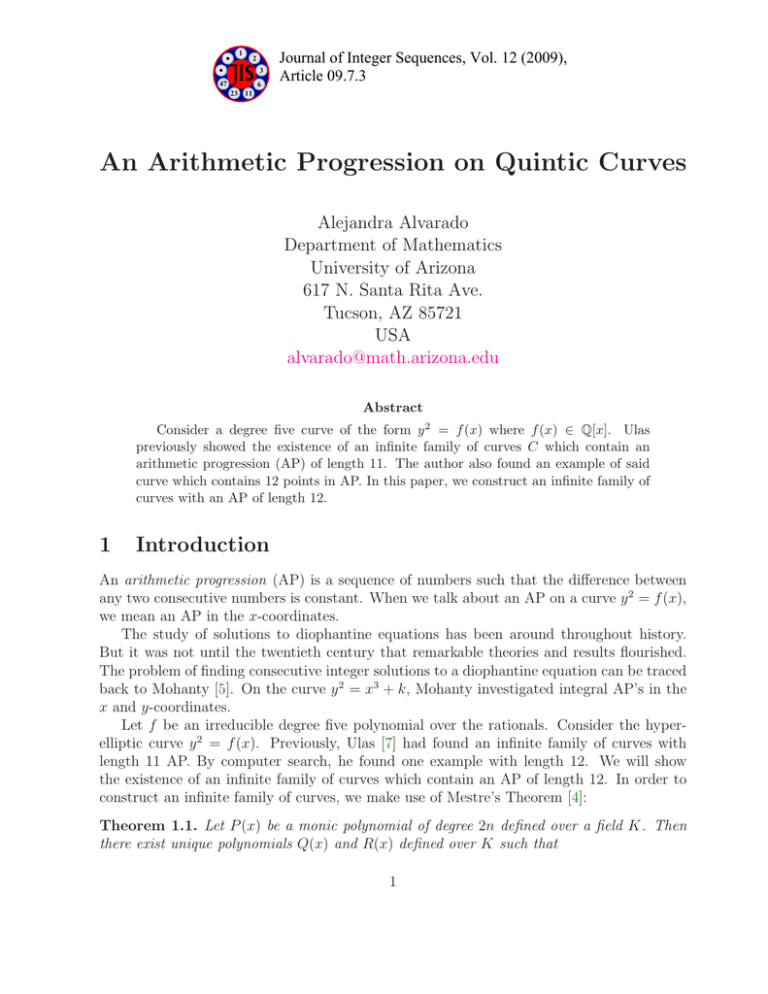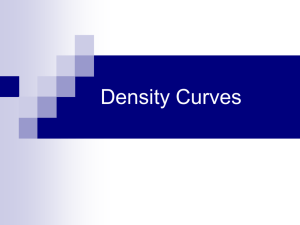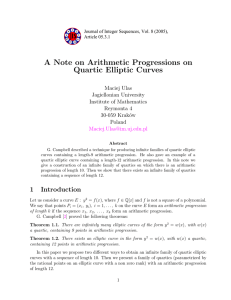An Arithmetic Progression on Quintic Curves
advertisement

1
2
3
47
6
Journal of Integer Sequences, Vol. 12 (2009),
Article 09.7.3
23 11
An Arithmetic Progression on Quintic Curves
Alejandra Alvarado
Department of Mathematics
University of Arizona
617 N. Santa Rita Ave.
Tucson, AZ 85721
USA
alvarado@math.arizona.edu
Abstract
Consider a degree five curve of the form y 2 = f (x) where f (x) ∈ Q[x]. Ulas
previously showed the existence of an infinite family of curves C which contain an
arithmetic progression (AP) of length 11. The author also found an example of said
curve which contains 12 points in AP. In this paper, we construct an infinite family of
curves with an AP of length 12.
1
Introduction
An arithmetic progression (AP) is a sequence of numbers such that the difference between
any two consecutive numbers is constant. When we talk about an AP on a curve y 2 = f (x),
we mean an AP in the x-coordinates.
The study of solutions to diophantine equations has been around throughout history.
But it was not until the twentieth century that remarkable theories and results flourished.
The problem of finding consecutive integer solutions to a diophantine equation can be traced
back to Mohanty [5]. On the curve y 2 = x3 + k, Mohanty investigated integral AP’s in the
x and y-coordinates.
Let f be an irreducible degree five polynomial over the rationals. Consider the hyperelliptic curve y 2 = f (x). Previously, Ulas [7] had found an infinite family of curves with
length 11 AP. By computer search, he found one example with length 12. We will show
the existence of an infinite family of curves which contain an AP of length 12. In order to
construct an infinite family of curves, we make use of Mestre’s Theorem [4]:
Theorem 1.1. Let P (x) be a monic polynomial of degree 2n defined over a field K. Then
there exist unique polynomials Q(x) and R(x) defined over K such that
1
1. P (x) = Q(x)2 − R(x)
2. the degree of R(x) is strictly less than n.
In this paper, we use the above theorem to construct an infinite family of curves.
2
Arithmetic Progressions of Length 12
In this section, we will prove the following theorem, whose proof uses similar techniques as
Campbell [3].
Theorem 2.1. There exists an infinite family of curves of the form y 2 = f (x) which contain
an arithmetic progression of length 12, where f is a degree five polynomial. The curves are
defined over the rationals.
Proof. Consider the following polynomial in Q(u)[x].
Y
(x2 − i2 )
g(u, x) = (x − u)2
1≤i≤5
We choose this form of polynomial to maximize the use of symmetry. Note that g vanishes
identically at x = ±1, . . . , ±5. By Mestre’s theorem, there exist unique polynomials h, f ∈
Q(u)[x] of degree 6 and 5, respectively such that
f (u, x) = h(u, x)2 − g(u, x).
We will write
h(u, x) = x6 + h5 x5 + h4 x4 + h3 x3 + h2 x2 + h1 x + h0 .
Since f is of degree 5, we easily find the coefficients hi .
f (u, x) = h(u, x)2 − g(u, x)
= 2(h5 + u)x11 + (h25 + 2h4 − u2 + 55)x10 + 2(h5 h4 + h3 − 55u)x9
+ (2h3 h5 + h24 + 2h2 + 55u2 − 1023)x8 + 2(h2 h5 + h3 h4 + h1 + 1023u)x7
+ (h23 + +2h1 h5 + 2h2 h4 + 2h0 − 1023u2 + 7645)x6 + 2(h0 h5 + h1 h4
+ h2 h3 − 7645u)x5 + (2h0 h4 + 2h1 h3 + h22 + 7645u2 − 21076)x4
+ (h0 h3 + h1 h2 + 21076u)x3 + (2h0 h2 + h21 − 21076u2 + 14400)x2
+ 2(h0 h1 − 14400u)x + (h20 + 14400u2 )
where
−55
2
1067
h2 =
8
−2475
h0 =
16
h5 = −u
h4 =
55
u
2
−1067
h1 =
u
8
h3 =
2
We can then write f as
−2475 5
61875 3
2475 2 334125
−210375 2 1719225
4
f (u, x) =
x −
x2
ux +
u +
ux +
u −
8
8
64
32
64
64
797625
6125625
2
+
ux + 14400u +
64
256
By construction, f (u, x) = h(u, x)2 for x = ±1, . . . , ±5. We now add the constraint that f
also be square at x = 0, so then we have an arithmetic progression of length at least 11 on
the curve C : p2 = f (u, x). We want f (u, 0) = p2 . In other words,
2475 2
) = p2 .
16
16 2
Without loss of generality, multiply through by ( 2475
) , then replace
as
128 2
u) + 1 = p21 .
(
165
We have a parametrization
(120u)2 + (
2t
128
u= 2
165
t −1
Thus, u = u(t) =
obtain the curve
165t
.
64(t2 −1)
p1 =
16
p
2475
with p1 . Rewrite
t2 + 1
t2 − 1
Substituting back for u in f (u, x), and removing any squares, we
P 2 = (−929280t3 + 929280t)x5
+ (6082560t4 − 9769320t2 + 6082560)x4
+ (−5808000t3 + 5808000t)x3
+ (−31297536t4 + 37139697t2 − 31297536)x2
+ (37435200t3 − 37435200t)x
+ (27878400t4 + 55756800t2 + 27878400)
18
2
2
(t+1)
where P = 2 (t−1)
p. The above curve has an arithmetic progression of length at
152
least 11, for t ∈ Q except t 6= ±1. The arithmetic progression of the x coordinates is
{−5, −4, . . . , 4, 5}. To find an arithmetic progression of length at least 12 on C, we need to
determine whether x = 6 or x = −6 gives us a point on the curve. At x = −6 we have
2
P
= 188449024t4 + 229333280t3 − 313007023t2 − 229333280t + 188449024
(2.1)
6
. Note that because of symmetry, t = − 65 also gives a
We find that t = 65 gives p = 34001
6
point on the curve. Now we have at least one curve with an arithmetic progression of length
at least 12. In particular, at t = 65 , the curve
y 2 = 70400x5 + 663960x4 + 440000x3 − 6128751x2 − 2836000x + 23814400
3
contains the x arithmetic progression {−6, −5, −4, . . . , 4, 5}
Returning to the quartic curve (2.1), since a rational point exists, the curve is birationally
equivalent to an elliptic curve. The quartic curve is commonly called a quartic elliptic
curve [7]. With the aid of MAGMA [1], we found the minimal model of the quartic elliptic
curve. The output is the elliptic curve, E,
Y 2 + XY + Y = X 3 + X 2
− 14206480669846430X
+ 651651670263534709965275.
We thus have the maps to and from the quartic and cubic curve. If this curve has rank
at least one, and if we can find at least one point on the curve of infinite order, then C will
have an arithmetic progression of length at least 12, namely,
x = −6, −5, −4, . . . , 5.
The following commands were entered into SAGE [6], to determine the rank of this curve
and find its generators.
E=mwrank_EllipticCurve([1,1,1,
-14206480669846430,651651670263534709965275])
E.rank() E.gens()
SAGE found the rank of F to be three, and its (possible) generators were found to be
[−118512027, −818950617977, 1]
[578945454, 404307680999, 8]
[68136369, −1117555865, 1]
So this constructs a three parameter family of degree five curves, containing an arithmetic
progression of length 12. The equation of the family of curves is,
y 2 = −929280(t3 − t)x5 + 3960(1536t4 − 2467t2 + 1536)x4
− 5808000(t3 − t)x3 − 9(3477504t4 − 4126633t2 + 3477504)x2
+ 37435200(t3 − t)x + 27878400(t4 + 2t2 + 1)
(2.2)
with x-AP,
√
{(−6, 6 188449024t4 + 229333280t3 − 313007023t2 − 229333280t + 188449024),
(−5, 15(3680t2 +2079t−3680)), (−4, 12(2744t2 +1485t−2744)), (−3, 3(5152t2 +2915t−5152)),
(−2, 6(16t2 + 1155t − 16)), (−1, 3(544t2 − 3135t − 544)), (0, 5280(t2 + 1)),
(1, 3(544t2 + 3135t − 544)), (2, 6(16t2 − 1155t − 16)), (3, 3(5152t2 − 2915t − 5152)),
(4, 12(2744t2 − 1485t − 2744)), (5, (3680t2 − 2079t − 3680))}.
Since we have a map from C to E, we can express t in terms of the points on E,
27124113X + 1405Y − 1429181772291724
t=
.
2(18185324X + 843Y − 1413723166396761)
4
3
An Arithmetic Progression of Length 13
It is natural to state the following question:
Open Question 3.1. Can we find a quintic curve containing a length 13 arithmetic progression?
By computer search, we attempted to find an example of length 13 AP on the curve (2.2).
By modifying the polynomial g(u, x), found at the beginning of section two, we attempted
to construct an example of length 13. Thus far, by ranging the degree of g from 12 to 14,
we have not found an example.
4
Acknowledgment
I would like to thank anonymous referee for his/her valuable comments, and A. Bremner for
guiding me towards this problem.
References
[1] W. Bosma, J. Cannon, and C. Playoust, MAGMA 2.14-1, available from
http://magma.maths.usyd.edu.au/.
[2] A. Bremner, On arithmetic progressions on elliptic curves, Experiment. Math. 8 (1999),
409–413.
[3] G. Campbell, A note on arithmetic progressions on elliptic curves, J. Integer Sequences
6 (2003), Paper 03.1.3.
[4] J. Mestre, Construction d’une courbe elliptique de rang ≥ 12, C. R. Acad. Sci. Paris
Sér. I Math. 295 (1982), 643–644.
[5] S. Mohanty, On consecutive integer solutions for y 2 − k = x3 , Proc. Amer. Math. Soc.
48 (1975), 281–285.
[6] W. Stein, SAGE: Software for Algebra and Geometry Experimentation. available from
http://www.sagemath.org
[7] M. Ulas, On arithmetic progressions on genus two curves, Rocky Mountain J. Math.
39 (2009), 971–980.
2000 Mathematics Subject Classification: 11G05, 11B25, 14H45.
Keywords: arithmetic progression, elliptic curves, quartic curves.
5
Received August 16 2009; revised version received October 19 2009. Published in Journal of
Integer Sequences, October 21 2009.
Return to Journal of Integer Sequences home page.
6







